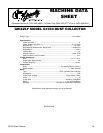
G1030 Dust Collector -15-
For mobility, the G1030 is mounted on casters
and can be moved within close proximity to your
woodworking machines. You will need a flexible
duct to connect each machine with a collection
hood. If you wish to specifically direct air flow
while the dust collector is attached to more than
one machine, you will need to add a blast gate for
each machine.
When moving the dust collector around the shop,
you must consider clearances between obstacles
and accessibility to convenient electrical outlets.
A heavy-duty extension cord may be used if an
outlet is not convenient. See Section 2 on Circuit
Requirements.
The G1030 can be set up as a stationary unit with
the addition of a fixed duct system to service
more than one machine at a time. The primary
advantage of a stationary system is it eliminates
the process of disconnecting and moving the dust
collector, hoses and cords, and eliminates hoses
and cords laying on the floor. Another advantage
of a stationary system is it allows the dust collec-
tor to be located away from the work area, reduc-
ing noise and freeing up valuable workshop
space. Grizzly offers a complete line of dust col-
lection accessories for setting up a stationary
system. Additionally, Grizzly offers a complete
guide book entitled Dust Collection Basics
for set-
ting up stationary dust collection systems. Please
refer to our current catalog for pricing and order-
ing information.
A stationary system configuration usually has a
main duct with smaller ducts branching to each
machine. The main duct should be located out of
the way of normal operations and be accessible
for the branch ducts. Branch ducts are perma-
nently attached to each machine by way of col-
lection hoods. Air flow is controlled by blast gates
located in the branch ducts and near each
machine. Remote switches, available from
Grizzly, can be added to make the system even
more convenient.
To design a stationary system, you must consid-
er many interrelated factors such as, shop layout,
woodworking machine capacities, and general
duct efficiency. Design considerations for a sta-
tionary dust collection system are beyond the
scope of this manual. As stated above, Dust
Collection Basics, offered by Grizzly, is an excel-
lent resource for dust collection questions.
StationaryMobile


















